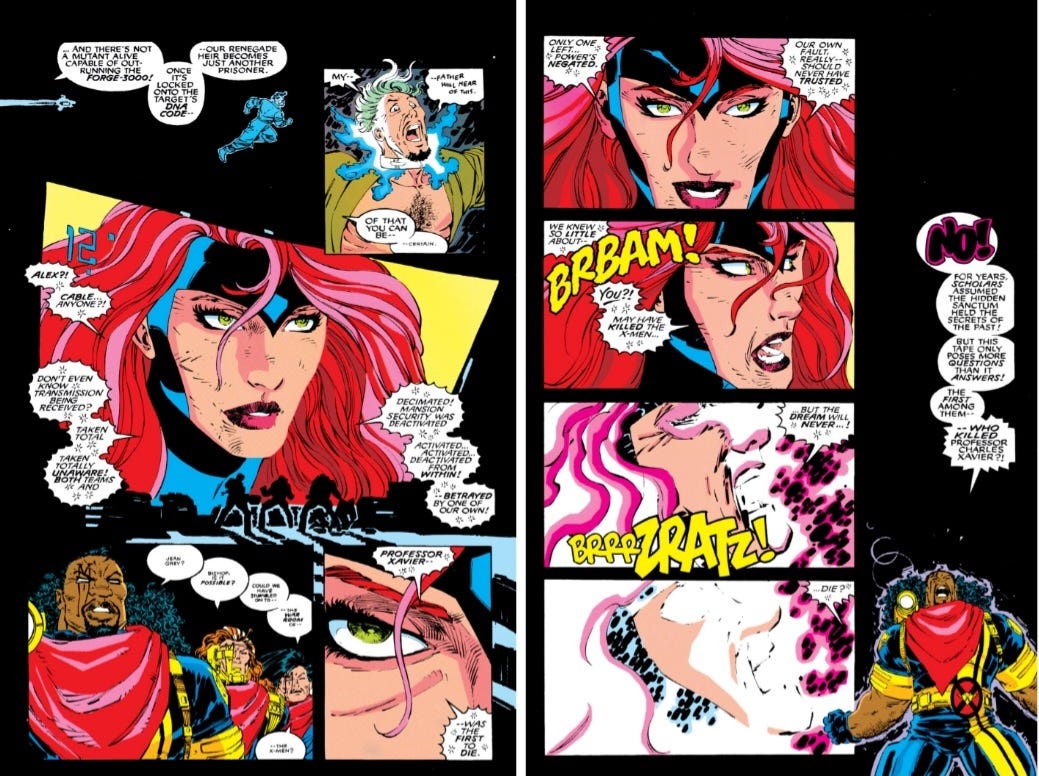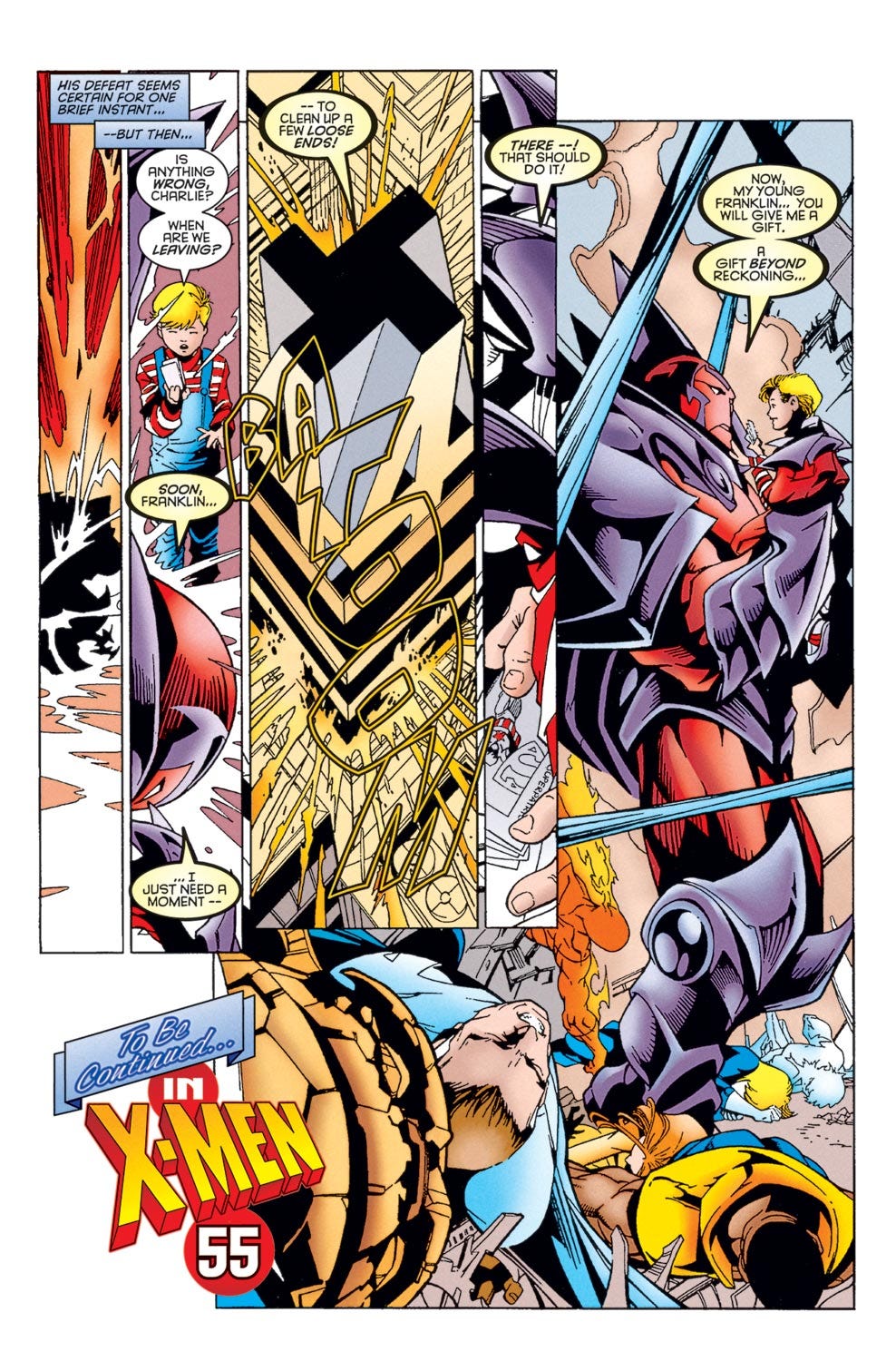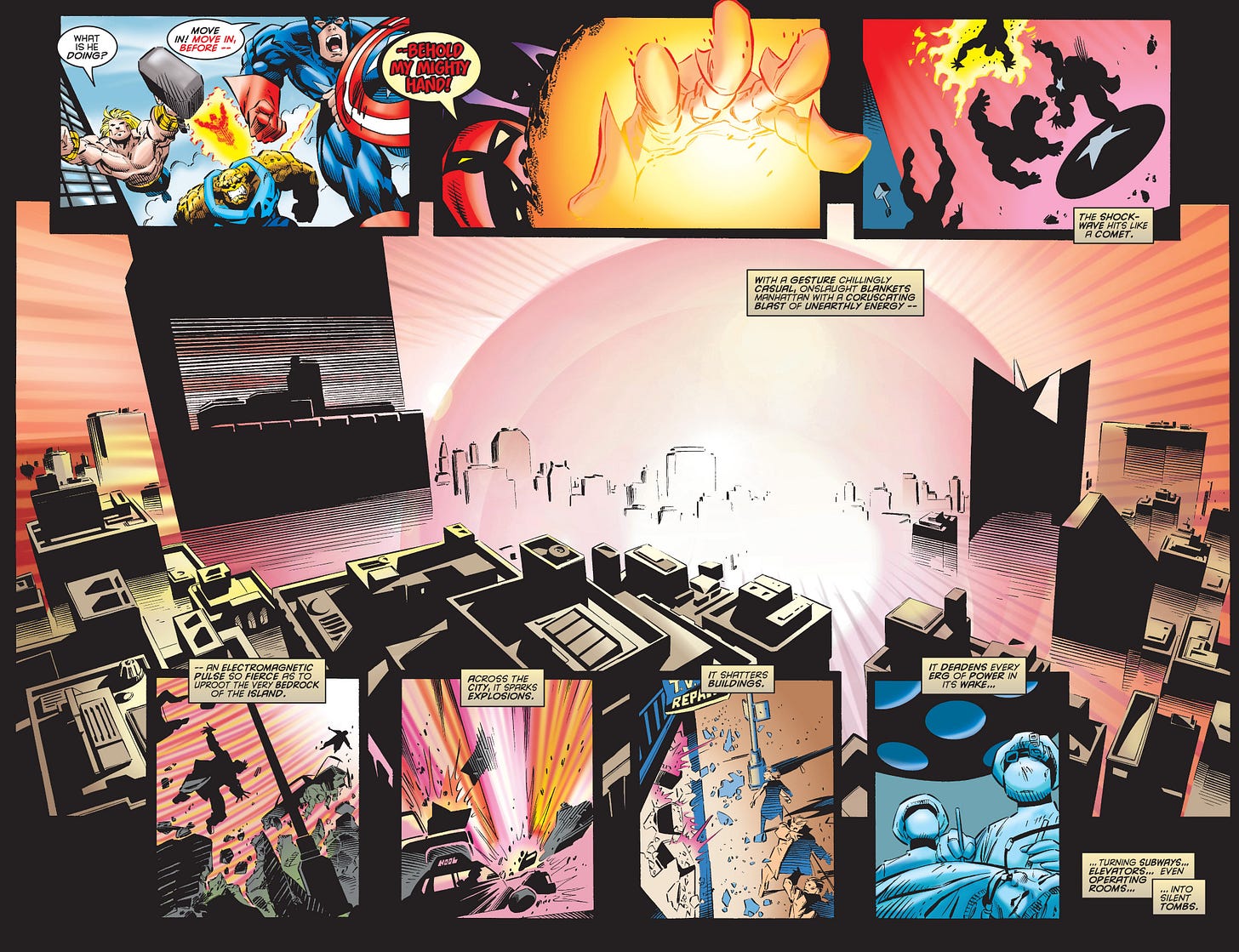Onslaught is not a well organized event. It’s not linear, moving from one part to another. Nor is it organized around a central series augmented by optional tie-ins. Onslaught sprawls across several series over the course of two months with no clearly defined spine or critical and non-critical issues. Issues are branded “phase” or “impact” with phase seemingly indicating primary issues and impact secondary. Yet some phase issues are unnecessary and some impact issues are critical. And the numbering system (issues are marked 1 or 2 depending on the month they were released) has no bearing on the event’s timeline. In short, continuity for Onslaught is a mess.
For this retrospective I have organized the above issues as Phase 1 (listed in as close to a suggested reading order as possible). Some issues have minor significance while others, despite branding, have none.
The First Fight
Onslaught: X-Men, coming immediately after X-Men 54, marks the true beginning of the event. Onslaught reveals himself in the early pages after declaring Xavier’s dream dead and saying mutants should rule humans (this idea is presented in very vague terms).
Most of the issue is a series of three fights between the X-Men and Onslaught. After each of the first two battles Onslaught, who just wiped the floor with his opponents, gives the X-Men an excuse justifying not killing them. The third time he simply says nothing and leaves. This will be an ongoing problem. Onslaught repeatedly defeats the heroes arrayed against him without difficulty, but he never kills them (or even tries to otherwise permanently incapacitate them).
This is a problem with all-powerful villains (Onslaught is frequently called the most powerful psi ever); logically they should eliminate their enemies. Obviously that isn’t an option in most cases, so writers typically invent story reasons for why the villains can’t or won’t go through with that. The writers never bother when it comes to Onslaught.
There are two noteworthy moments in the issue. The first is Onslaught revealing to McCoy that he knew McCoy had replaced Beast. The second is the payoff for the fragmented message Bishop saw in the future (in Uncanny X-Men 287) which is revealed to be about Xavier.
Gathering Forces
Uncanny X-Men 335 follows and is focused on recap and strategy. It teams the Avengers with the X-Men, sending them all in different directions. One mixed team of X-Men and Avengers leaves to find Magneto (connected to the creation of Onslaught, via scant evidence at this point, as a result of the mindwipe from X-Men 25) while another mixed team is sent to protect Franklin Richards. A few remaining X-Men set off to Muir Island. X-Force, also at the mansion, is tasked with protecting Nate Grey. Meanwhile, Apocalypse is introduced. He will speechify a lot and have nothing to do with the story.
X-Force and Nate Grey are attacked immediately by Mr. Sinister who kidnaps Nate to service a subplot focused on Sinister and Apocalypse’s feud. While Nate will factor into Onslaught’s second phase, the Sinister subplot has no bearing on the event.
The X-Men who go to Muir Island unlock the Xavier Protocols which is a database of detailed strategies on how to kill each and every X-Man (Xavier included). The X-Men are rightfully horrified that their mentor had created such a thing.
The first Avengers/X-Men team tracks down Joseph and Rogue. After a perfunctory hero versus hero battle Joseph, having been told about Magneto’s possible role in the creation of Onslaught, agrees to go back and help. This begins a Joseph character arc that runs through the event and proves to be one of its most successful parts.
The second team arrives at Four Freedoms Plaza and directly confronts Onslaught who is attempting to kidnap Franklin. Onslaught, of course, wins with relative ease. A few X-Men, half the Avengers, and all of the Fantastic Four lie defeated and unconscious at Onslaught’s feet but he takes no further action against them. Perhaps Onslaught couldn’t take the time because of the urgency of needing to take Franklin. Or perhaps Onslaught believed Franklin would make him unstoppable and in his arrogance didn’t feel the need to eliminate the heroes. Maybe Onslaught was just tapped out. In any event, Onslaught abducts Franklin without comment, leaving all his enemies alive and in relative fighting form.
This kind of lazy plot development and half-hearted writing (which we already saw in Onslaught: X-Men) will be a hallmark of the event. For every successful character arc and compelling tie-in issue there are major plot points and character motivations in the primary story (as well as one very bizarre continuity error) that make no sense whatsoever. Perhaps this is a side effect of Onslaught being designed to meet an editorial need rather than to tell a story in its own right. But whatever the case, it speaks to writers who either couldn’t or simply didn’t create a cohesive narrative.
The Fluff
Wolverine, having set off on his own, is able to get a psychic tour of the past where he watches the moment when Xavier mindwiped Magneto and sees a homunculus (in this case a representation of Magneto’s “dark ego” instead of Magneto himself) travel from Magneto into Xavier. If this is taken as fact (despite never being referenced again and somewhat contradicting Onslaught’s origin), it effectively absolves both Magneto/Joseph and Xavier of any responsibility for Onslaught because their core personalities aren’t driving.
While these major developments are happening, the McCoy/Beast story is resolved in X-Factor (though Beast will not participate in the remainder of the event), Cable fights the Hulk who was brainwashed by Onslaught (with no explanation at all for how or when that happened), and Generation X runs away, never to be seen or talked about in the event). None of these bear on the main story (despite several being labeled “phase” issues), and the Generation X issues are the worst example of a dishonest sales juicing cash grab.
The Battle of New York
The X-Men, Avengers, and Fantastic Four join forces in X-Men 55. Onslaught has launched a wave of sentinels against New York City (which follows up on the hints from Uncanny X-Men 333). The motive behind this is unclear. The sentinels are supposed to occupy and seal off the city but don’t appear to have any stated goal except killing superhumans who fight back. They all but ignore the humans. When the assemblage of heroes attack, Onslaught forces Franklin to use his vague reality altering powers to create a giant tower in Central Park. Onslaught then unleashes a massive EMP, shutting down the city and utterly defeating the heroes. But as you might suspect he doesn’t deliver a finishing blow, and once again the writer doesn’t try explaining why.
Meanwhile, Spider-Man, Green Goblin, and Punisher deal with the sentinel invasion of New York. These issues are of mixed quality. The Punisher issue is silly. The Green Goblin issue is significant if you’re following that series. The Spider-Man issues end with Ben and Peter rushing to Central Park to join the fight against Onslaught. However, they will not be seen again. I assume this was bad coordination between the assorted writers. All the humans in the final battle are bound for the Heroes Reborn universe and sacrifice themselves accordingly. Spider-Man isn’t in Heroes Reborn so him being at the fight but refusing to sacrifice would look bad. There was likely no intention of having him in the finale.
Small, Medium, or Large?
There can be no argument that the writing in Onslaught is flawed, and those flaws likely contributed to the artistic design of Onslaught himself. In this retrospective’s Prologue to Onslaught entry I wrote at length about the inconsistencies surrounding Onslaught’s physical nature. In that case the problems were largely a result of story points in Uncanny X-Men 322 and an inability or failure to retcon them. Unfortunately these inconsistencies continue—in fact, they get worse.
In X-Men 54 and Onslaught: X-Men, Onslaught is depicted with his armor atop Xavier’s human body. In Uncanny X-Men 335, Xavier is depicted as a man in a fetal position deep inside Onslaught’s being (which is confusing given their relative sizes). In X-Men 55 it’s unclear where Franklin is–whether somehow inside Onslaught or in his tower (in future issues he will be seen in both places). And all of this leaves out the question of when Franklin and Xavier are seen as physical people as opposed to entities on the astral plane (which comes up in Phase 2).
The original problems caused by Uncanny X-Men 322 are understandable—Lobdell had nothing in mind when he first mentioned Onslaught. And we have no way of knowing when Onslaught’s design was finalized leading up to Onslaught: X-Men. The character wasn’t seen in detail until X-Men 53, wasn’t seen relative to Xavier until X-Men 54, and wasn’t seen in action until Onslaught: X-Men. But with the event now underway, there is really no excuse for there to be inconsistency (sometimes wild inconsistency) in the titular villain’s appearance.
Good and Bad
Despite my criticisms, there are a lot of individual pieces to like in Phase 1. Joseph’s arc of a man trying to redeem himself (which runs through to the end) is compelling and well written. The Cable material is enjoyable even if the fight with Hulk is lackluster. The Spider-Man and Green Goblin issues (especially Green Goblin) are engaging character pieces if you’re following either series. And the art throughout is top of the line; Bachalo In Generation X, Skroce in X-Man, and Kubert in X-Men are especially impressive.
However, the event itself (to say nothing of its titular character) is not built upon a solid foundation. The longer the event goes on, the more wobbly it becomes. And the introduction of superfluous characters like Apocalypse and Mr. Sinister feels like an attempt to throw as many elements as possible into a blender and hope that what comes out is gold. At this point it’s not so unsteady that it couldn’t be saved with a better fleshed out Onslaught and a strong ending. Unfortunately, that will not be how the second half goes.
<— Previous: Prologue to Onslaught
“Road to Onslaught” and “Prelude to Onslaught” really only have meaning insofar as which issues Marvel put into each collection…
Next: Onslaught Phase 2 —>
Considering its lengthy build up, it’s a surprise that Onslaught only lasted two months. For as big a story as it tried to tell, the event is shockingly short…
Check out the Introduction for an index of posts. For issue-by-issue commentary of every issue, visit my Twitter @theronscomics #MarvelOnslaught.
Thanks For Reading!
I love making comic book content, but it takes a lot of time. If you’re so inclined, donations make a big difference. And thanks to everyone who has chipped in!
Did you enjoy the post? Feel free to share it!
Want to add to the discussion? Drop a comment! Want reviews and other content straight to your inbox?
If you like my comic content and are into video games, I do walkthroughs with detailed story analysis at Bookishly Gaming.
Find my content all over the internet.














